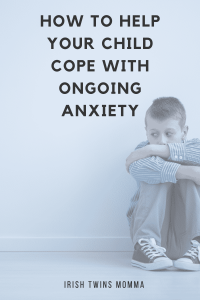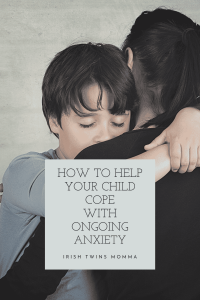This post contains affiliate links. If you click and buy, I may make a commission, at no cost to you. See my disclosure policy for more information.
Change is inevitable. Change is also a challenge that produces a great horde of worry. This worry manifests itself deeply in rooted anxiety. Truly, while the world can be an absolute marvel full of fascinating wonders, it’s also a stockpile of harrowing triggers thrown our way. So much has changed within the past year.
Few things are more difficult to endure than seeing your young child struggle with anxiety. If your child is dealing with perpetual feelings of unease and stress, it’s time to step up as a parent and help them deal with the worry-monster that lives inside their head. If you’re wondering what you can do as a role model during difficult circumstances, here’s how to help your child cope with ongoing anxiety.

Acknowledge But Don’t Empower
Worry, in broad terms, is a relative form of protection. This protection mechanism is ingrained in all humans. Thoughts of worry are not the truth, but they serve a distinct purpose in our lives. These worries are not something to be feared. You should verbally acknowledge your kid’s worries when they look to you for affirmation. You are the one that can listen, empathize, and validate how they feel.
However, it’s naïve to be starry-eyed about life. Worry is meant for survival—it’s instinctive and everyone experiences it from time to time. What you can best do is simply allow them to worry and work through it together. You can personify your kid’s worry but not empower it. Anxiety is perceiving things that aren’t real as real threats. You can’t entirely eliminate their anxiety but you can help them sort out the reality of their thoughts to manage them logically.
Encourage Changing “What Ifs” To “What Is”
Worry is a type of mental time travel. While we all have thoughts of the past, present, and future, anxiety embodies itself far off in future events while existing in the present time. “What-if” questions are an exasperated component of this mental travel—“What if this happens?” “What if I become…?” “What if you…?”
What if it didn’t matter? Help your child to see that what-ifs are only possibilities. Encourage them to see what truly is and bring them back to the present. This is a valid way of how to help your child cope with ongoing anxiety. The greatest human strength is being able to make sense and make do with what we have and where we are. Children may be little, but they can be the most resilient of us all.
Focus on Calming Activities
The goal you’re reaching for with your child is not to completely defeat anxiety. Anxiety is a part of life, but it can be better managed with the right mindset and skills. As a parent, you can help your child by providing them with tools and skills to manage anxiety. You can do this by focusing on specific activities that can calm and comfort them.
Did you know there’s a link between slime and ASMR? Playing with slime, coloring, crafting, and listening to calm music or videos are all sensory activities that are beneficial to soothe and regulate emotions. The auditory, tactile, and visual simulation focuses on the present to help keep worries at bay.
Sincerely,




Leave a Reply